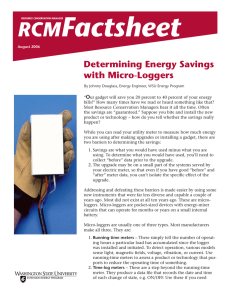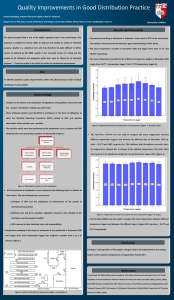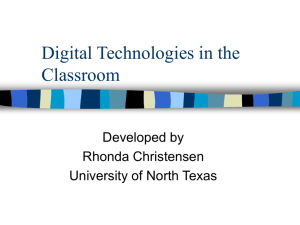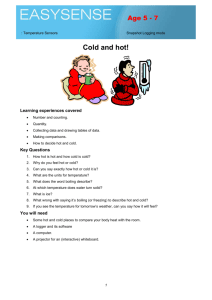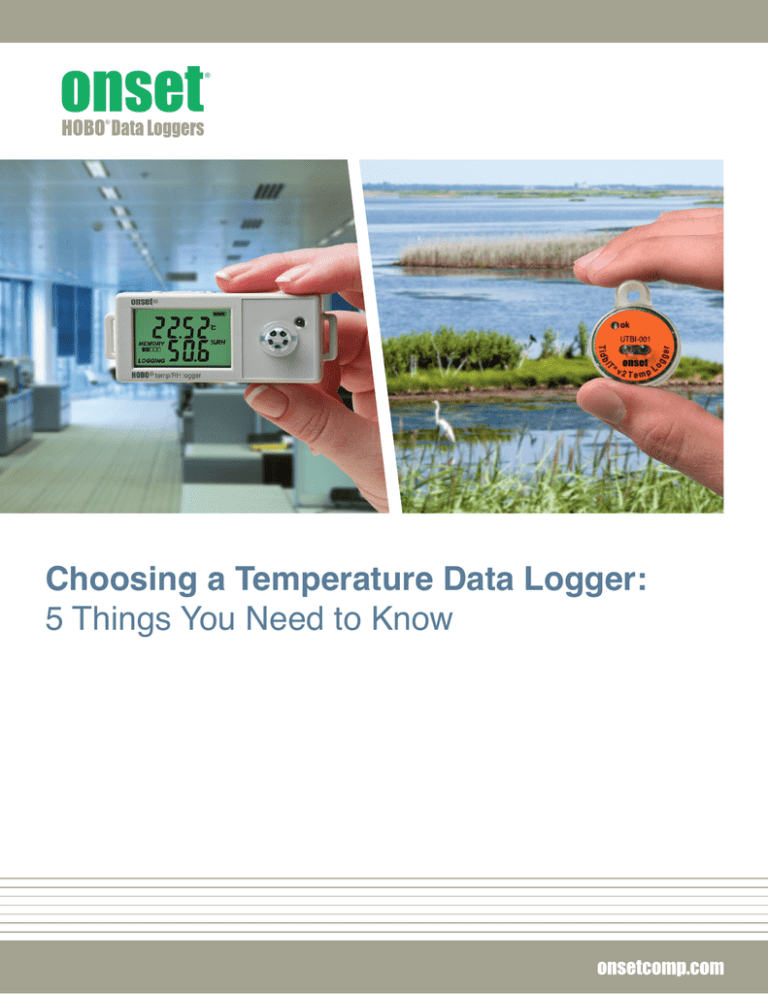
Choosing a Temperature Data Logger:
5 Things You Need to Know
onset ®
Introduction
The measurement accuracy
offered by today’s most
advanced data loggers rivals
the performance of many
higher priced, computer-based
data acquisition systems.
Battery-powered temperature data loggers are widely used by performance
contractors, service technicians, and engineers responsible for monitoring
indoor environmental conditions, investigating occupant comfort complaints,
adjusting temperature setbacks, and evaluating HVAC/R (Heating/Ventilation/
Air Conditioning/Refrigeration) systems. Temperature data loggers are
also used by research scientists, ecologists, and hydrologists looking to
continuously monitor soil, air, and water temperature without having to be on
site.
Data loggers, in most cases, are easy to deploy, and can be used as standalone devices without a computer. More importantly, the measurement
accuracy offered by today’s most advanced data loggers rivals the
performance of many higher priced, computer-based data acquisition systems.
However, not all temperature data loggers are created equal, and with so
many choices available today, it can be challenging to know which one is right
for your application. Do you need to measure a range of conditions, or just
a single parameter? Does your application require alarm notification when
conditions go beyond a certain threshold? Will the data logger withstand harsh
environments? Does it need to be weatherproof or waterproof? How often will
you need to offload data? Will you be viewing collected data on a computer, or
a mobile device?
Whether you are an experienced data logger user, or just getting started, this
article can help you during the temperature logger selection process. It points
out some of the most important considerations to keep in mind, and offers tips
on specific features.
1
1-800-LOGGERS
onset ®
1. Know your accuracy requirements
No matter what you need to measure, understanding your measurement
accuracy requirements is essential. For example, if you’re monitoring
air-conditioning temperature in an office space, you may only require a
temperature measurement accuracy of +/- 1C, while monitoring conditions in a
research lab may require far greater accuracy. Or when monitoring streams for
suitability for certain fish species, for example, accuracy on the order of 0.2C is
typically required.
Accuracy specifications vary widely among different types of data loggers,
and a good understanding of specific accuracy requirements will help you
avoid paying for accuracy you might not need. When looking at the accuracy
specifications for a given data logger, be sure to look for charts that indicate
accuracy over an entire measurement range, not just a single value. The
accuracy a data logger can achieve at the high or low end of a given range
may be far different from the accuracy at the middle of the range.
Another important factor is data logger resolution; that is, the number of
increments of a value a data logger is capable of reporting. For example,
a data logger with 12-bit resolution can report 4,096 values over a given
temperature range. While a 16-bit data logger may offer more resolution than
a 12-bit model, it’s important to keep in mind that higher resolution does not
necessarily mean better measurements.
If you’re unsure about the data logger accuracy and resolution requirements
of your application, an experienced data logger supplier should be able to help
you determine which product will best meet your needs.
Using a Temperature Data Logger
1. Configure and launch
2. Secure in place
3. Download or access data
4. Process/analyze data
Install and start HOBOware CD
in your computer.
Deploy the data logger
in the desired location.
Securing it in place can
be as simple as using a
magnet, screw, or lanyard
to fasten it to a wall.
After the desired monitoring
period, reconnect the data
logger to the computer, and
launch the software to read out
the data.
The data logger’s software
allows you to combine and
compare data, and display
the measurements in
graphs that show profiles
over time.
Connect your data logger to
your computer via USB and set
parameters. (BLE data loggers
can be configured and launched
wirelessly, after deployment.)
www.onsetcomp.com
With BLE loggers, data are
downloaded directly to your
mobile device.
2
onset ®
2. Anticipate your data access needs
Wireless temperature data
loggers transmit highly
accurate temperature/RH data
from dozens of points to a
central location.
With the simplest stand-alone data loggers, temperature data is directly
offloaded to a computer via a USB interface. In many instances, however, it’s
not practical to bring a computer out to a site, nor is it always convenient to
bring a data logger back to an office computer. In such cases, data retrieval
from stand-alone loggers can instead be easily and quickly accomplished
using a pocket-sized device called a data shuttle. With a shuttle (or waterproof
shuttle), you can download and store the collected data without having to
interrupt or move the logger, and later link the shuttle to a computer for
downloading and analyzing the data.
Wireless temperature data loggers can transmit real-time temperature/
relative humidity (RH) data from dozens of points to a central location. With a
networked arrangement, the chore of manual retrieval and offloading of data
from individual loggers is eliminated.
Web-based data logging systems enable real-time remote access to
temperature and other types of data via cellular, Wi-Fi, or Ethernet
communications, and can be configured with a wide range of plug-and-play
sensors. Data can be accessed easily through a secure website or integrated
into custom systems with a relatively simple-to-implement set of web services.
Data loggers that utilize Bluetooth Low Energy (BLE) technology measure
and transmit temperature data wirelessly to mobile devices over a 100-foot
range. This is particularly useful in applications where data loggers need to be
deployed in hard-to-reach spaces or in limited-access areas within a facility.
USB Loggers
Bluetooth Loggers
Wireless Sensors
Web-Based Systems
Short or long-term trend logging with
manual offload
Wireless data access via mobile
devices
Short-range centralized data
collection
Long-range wireless internet access
Internet
3
1-800-LOGGERS
onset ®
3. Look for time-saving features
Time is money, so you’ll want to make sure the temperature data logger you
select has a feature set that will make the process of field deployment
simple and reliable. Here are some features you’ll want to consider:
•Memory capacity – Make sure the logger has enough memory
to allow for longer deployments with fewer site visits. Low-cost loggers
can store 6,000 measurements which is enough for some applications.
For longer deployments or faster logging, higher-capacity loggers are
readily available with capacities of over 1 million measurements.
•Deployment flexibility – Since temperature loggers are typically deployed
in a wide range of environments and spaces, they often need to be
mounted in different ways. Look for options like mounting eyelets,
magnets, straps, and command-strips to streamline the mounting
process and help ensure reliable deployments.
•Durability – Select ruggedly-built loggers that can withstand extended
deployment in harsh environments, including extreme weather
conditions or submergence in fresh or salt water, if required.
•Visual display – Temperature loggers with LCD displays enable you
to visually confirm logger operation and battery status in the field,
eliminating the need to connect the logger to a computer to view the
information.
•Start & Stop push buttons – A temperature logger you can start,
stop, or resume with the simple push of a button can make life easier
when at the job site.
•Firmware upgrades – A temperature logger with firmware that you can
upgrade from the field offers much greater convenience than having to
send the unit back to the manufacturer for upgrades.
It’s also a good idea to look for features that can save time when offloading
and analyzing data. Some temperature loggers, for example, can operate in
a statistics logging mode where they continuously calculate and display the
minimum, maximum, average, and standard deviation for measurements as
they are being recorded. This eliminates the need to post-process data to
generate these statistics.
BLE data loggers require no dedicated equipment beyond
a smartphone or tablet for configuring the logger and reading out data, saving
both time and money.
www.onsetcomp.com
4
onset ®
4. Don’t overlook the software
The software should enable you
to quickly and easily perform
tasks such as configuring
parameters, starting the data
logger, and offloading data,
with point-and-click simplicity.
Just as there are many different types of temperature loggers available, there
are also many different types of data graphing and analysis software packages.
In general, look for software that is Windows or Macintosh-based, depending
on your requirements, and highly intuitive so the learning curve is minimal.
The software should enable you to quickly and easily perform tasks such as
configuring parameters, starting the data logger, and offloading data, with pointand-click simplicity. Certain packages allow you to batch-configure and read
out hundreds of loggers very quickly.
The data logging software package should also offer powerful data plotting
capabilities, with an ability to easily merge, append, and crop data, and enable
you to easily export data to other programs, such as Microsoft Excel, for
analysis.
For BLE data loggers, you’ll want an app that allows you to configure loggers,
view data in graphs, share data files for analysis in Excel, Numbers, and other
applications, and store data in the cloud.
5
1-800-LOGGERS
onset ®
5. Consider power requirements
Overall, data loggers are extremely low-power devices. However, because they
are used in a variety of environmental conditions and sample at different rates,
battery life can vary widely. As a general rule of thumb, make sure the data logger
you select has a battery life of at least one year at the logging rate you need. For
some remote situations, you may want to investigate whether a solar-powered
option is available.
Battery
You should also look at whether the logger’s batteries are replaceable. Userreplaceable batteries are the most convenient, as this can eliminate the time
and expense of having to ship the logger back to the manufacturer for battery
replacement. Data loggers that run off standard household batteries offer
greater convenience than those requiring specialized batteries.
The batteries in some loggers are not replaceable; in this case the logger must
be replaced when the batteries run out.
www.onsetcomp.com
6
onset ®
Temperature Logging Application Examples
Museum Preservation
Challenge:
• Prevent deterioration of natural history museum collection
• Comply with restrictions associated with historical landmarks
• Monitor and maintain stable temperature/RH levels throughout
420,000 square feet of museum space
Solution:
• 50 wireless data loggers with integrated
temperature and RH sensors
• Discreet deployment of data nodes via non-marking 3M adhesive strips
• Real-time data, instant notification potential, and onboard buffer memory to ensure no data are lost
Results:
• Convenient offload of data from multiple locations
• Prompt identification, diagnosis, and resolution of HVAC equipment dysfunction
Climate Monitoring
Challenge:
• Manage agricultural risks related to weather and pests;
minimize use of pesticides
• Fully utilize the power of weather-based models
• Provide a user-friendly decision support tool that doesn’t
involve additional work for growers
Solution:
• Deployment of on-site web-based weather stations
• Transmittal of live air temperature, relative humidity, wind speed, and additional weather data to the Internet via
integrated Wi-Fi communication modules
Results:
• Accessible, accurate, farm-specific weather data
• Information helps growers with actionable pest management decisions
7
1-800-LOGGERS
onset ®
Cold Storage Temperature Monitoring
Challenge:
• Maintain high quality/safety standards at food production company
• Implement reliable backup temperature monitoring system in cold
storage areas
Solution:
• Several temperature data loggers
• Temperature recorded at five-minute intervals, around the clock
• Data analyzed on an as-needed basis, with verification at least once a
month
Results:
• Correlation of building automation system alarms with time-stamped readings from data loggers
• Second level of assurance that proper temperatures are being maintained
• Real-time temperature data on an easy-to-read LCD screen
Water Monitoring
Challenge:
• Restore and preserve freshwater ecosystem
• Decrease stream temperature to increase pool habitat for native fish
• Support healthier fish populations and a larger beaver population
Solution:
• Create active connections between three natural springs and the
creek to provide new sources of cool water and additional stream-flow
• Install water temperature data loggers above and below each spring
confluence with the creek to collect pre- and post-project stream temperature data
Results:
• Charted stream-flow and temperature information from data collected at 30-minute intervals and downloaded
approximately four times per year via HOBO Waterproof Shuttle
• Data helped determine how effective the connection of the springs to the creek was in lowering stream temperature
www.onsetcomp.com
8
onset ®
Other informational resources available from Onset:
Choosing an Occupancy and Light On/Off Data Logger
– 5 Important Considerations
Monitoring Green Roof Performance with Weather
Stations
This paper provides guidance on features to consider when
choosing an occupancy and light on/off data logger, including
calibration, LCD display, logger accuracy and range, speed of
deployment, and time-saving software. Learn how to select the
right logger for identifying ideal locations in your building where
changes in lighting could result in cost savings up to 80%.
Data logging weather stations are the ideal tools for documenting
green roof performance. A weather station can measure weather
parameters such as rainfall, stormwater runoff, temperature,
relative humidity, wind speed, solar radiation, and a host of nonweather parameters such as soil moisture on a continuous basis
(say every five minutes, hourly, or an interval appropriate to the
situation).
Utility Incentive Programs: How to Get More Money
Quickly and Easily
“Utility Incentive Programs: How to Get More Money Quickly
and Easily,” is aimed at making the process of applying for and
receiving energy efficiency incentives and rebates faster, easier,
and more rewarding. Authored by Carbon Lighthouse, an energy
firm that makes it profitable for commercial and industrial buildings
to eliminate their carbon footprint, the paper discusses the two
main types of incentive and rebate programs, how utility efficiency
program managers think, and how to use data to get more
incentive dollars for your projects.
Deploying Weather Stations: A Best Practices Guide
From the tropics to the poles, climate, agriculture and other
researchers rely on unattended research-grade, data logging
weather stations. For example, the US Department of Agriculture
uses weather stations to study anything from molecular plant
pathology to forest management. Non-government groups, such
as universities, use weather stations to study a wide array of
subjects including how glacial activity affects air temperature.
Additionally, commercial companies depend on weather stations to
conduct businesses.
Data Logger Basics
In today’s data-driven world of satellite uplinks, wireless networks,
and the Internet, it is common to hear the terms “data logging” and
“data loggers” and not really have a firm grasp of what they are.
Most people have a vague idea that data logging involves
electronically collecting information about the status of something
in the environment, such as temperature, relative humidity, or
energy use. They’re right, but that’s just a small view of what data
logging is.
Addressing Comfort Complaints With Data Loggers
This paper offers facility managers, HVAC contractors, and others
with valuable tips on how low-cost data loggers can be used to
validate temperature-related comfort complaints.
Access our full resources library at:
www.onsetcomp.com/learning
www.onsetcomp.com
Using Data Loggers Beyond Equipment Scheduling
While data loggers are a great tool for identifying equipmentscheduling opportunities in buildings, their usefulness far exceeds
just that one function. This paper discusses how the use of
inexpensive data loggers and some spreadsheet analysis can
provide all the evidence needed to make powerful buildingspecific cases for saving money by replacing failed air-handler
economizers. It also describes how information from data loggers
can be used to accurately calculate the energy savings that can
be realized from variable frequency drives (VFDs) on pumps and
fans, supply air resets, and boiler lockouts
Monitoring Wetlands with Data Loggers: A Best
Practices Guide
Wetlands act as a natural filter for polluted water and thus play an
essential role in water quality protection. They serve as floodwater
storage to help minimize erosion, and create a habitat for many
fish and wildlife.
While a variety of factors have decreased the number of wetlands
in the U.S. by half since 1950, many organizations are restoring
wetlands back to their original flourishing ecosystems. To ensure
success, it is necessary to monitor wetland factors such as water
level, temperature, and rainfall.
Finding Hidden Energy Waste with Data Loggers: 8
Cost-Saving Opportunities
The first step to reducing building energy costs is identifying
energy waste. Statistics on utility bills or name plates on
equipment, while useful, are not enough to identify what practices
and equipment are contributing to high energy use. Portable data
loggers can be used to obtain critical energy use information in
a wide range of commercial building types – from manufacturing
plants to office buildings.
Monitoring HVAC Performance with Data Loggers
This paper is for building operators and managers who have
the difficult job of providing comfortable working conditions
and coaxing aging mechanical equipment to operate at peak
performance while minimizing energy costs.
1-800-LOGGERS
onset ®
About Onset
Onset is a leading supplier of data loggers. Our HOBO data logger products are used around the world in a
broad range of monitoring applications, from verifying the performance of green buildings and renewable energy
systems to agricultural and coastal research.
Based on Cape Cod, Massachusetts, Onset has been designing and manufacturing its HOBO data loggers on
site since the company’s founding in 1981.
Contact Us
Our goal is to make your data logging project a success. Our product application specialists are available to
discuss your needs and recommend the right solution for your project.
Sales (8am to 5pm ET, Monday through Friday)
Email sales@onsetcomp.com
Call 508-759-9500
In US call toll free 800-564-4377
Fax 508-759-9100
Onset Computer Corporation
470 MacArthur Blvd.
Bourne, MA 02532
Technical Support (8am to 8pm ET, Monday through Friday)
Email loggerhelp@onsetcomp.com
Call 508-759-9500
In US call toll free 877-564-4377
Copyright© 2015, Onset Computer Corporation. All information in this document is subject to change without notice. Onset and HOBO are registered trademarks of Onset Computer Corporation.
All other trademarks are the property of their respective owners. All rights reserved. Printed in the USA. Lit. No. MKT1121-0815


